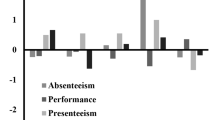Abstract
Differences among full-time (n=1066), part-time (n=132), and moonlighting employees (n=153) in a variety of occupations were examined. Moonlighters as compared to full-timers were younger, more frequently male, perceived less educational fit with their main jobs, and were primary wage earners. Full-timers as compared to part-timers were more frequently male, married, and primary wage earners. Part-timers had the greatest turnover, but no differences were detected for other withdrawal behaviors. Part-timers were more satisified with working conditions but were less satisfied with extrinsic rewards and life in general. Moonlighters expressed a stronger work ethic and placed less importance on working conditions.
Similar content being viewed by others
References
Borgen, F., & Seling, M. (1978). The uses of discriminant analysis following MANOVA: Multivariate statistics for multivariate purposes.Journal of Applied Psychology, 63, 689–697.
Dempster-McClain, D., & Moen, P. (1989). Moonlighting husbands: A life-cycle perspective.Work & Occupations, 16, 43–64.
Driver, M. J. (1979). Career concepts and career management in organizations. In C. L. Cooper (Ed.),Behavioral problems in organizations (pp. 79–139). Englewood Cliffs, NJ: Prentice-Hall.
Hedges, J. N., & Taylor, D. E. (1980). Recent trends in worktime: Hours edge downward.Monthly Labor Review, 103(3), 3–11.
Jackofsky, E. F., & Peters, L. H. (1987). Part-time versus full-time employment status differences: A replication and extension.Journal of Occupational Behavior, 8, 1–9.
Jamal, M. (1986). Moonlighting: Personal, social, and organizational consequences.Human Relations, 39, 977–990.
Jamal, M., & Crawford, R. L. (1981). Consequences of extended work hours: A comparison of moonlighters, overtimers, and modal employees.Human Resource Management, 20(3), 18–23.
Katerberg, R., Jr., Hom, P. W., & Hulin, C. L. (1979). Effects of job complexity on the reactions of part-time employees.Organizational Behavior and Human Performance, 24, 317–332.
Logan, N., O'Reilly, C., & Roberts, K. H. (1973). Job satisfaction among part-time and full-time employees.Journal of Vocational Behavior, 3, 33–41.
Martin, J. K., & Shehan, C. L. (1989). Education and job satisfaction: The influences of gender, wage-earning status, and job values.Work and Occupations, 16, 184–199.
Moen, P., & Moorehouse, M. (1983). Overtime over the life cycle: A test of the life cycle squeeze hypothesis. In H. Z. Lopata & J. H. Pleck (Eds.),Research in the interweave of social roles: Jobs and families (Vol. 3, pp. 187–200). Greenwich, CT: JAI.
Nardone, T. J. (1986). Part-time workers: Who are they?Monthly Labor Review, 109(1), 113–119.
Nollen, S. D. (1979).New patterns of work: Highlights of the literature. Scarsday, NY: Work in American Institute.
Peters, L. H., Jackofsky, E. F., & Salter, J. R. (1981). Predicting turnover: A comparison of part-time and full-time employees.Journal of Occupational Behavior, 2, 89–98.
Quinn, R. P., & Shepard, L. (1974).The 1972–73 quality of employment survey: Descriptive statistics with comparison data from the 1969–70 survey of working conditions. Ann Arbor: Institute for Social Research.
Rotchford, N., & Roberts, K. (1982). Part-time workers as missing persons in organizational research.Academy of Management Review, 7, 228–234.
Vecchio, R. P. (1984). Demographic and attitudinal differences between part-time and full-time employees.Journal of Occupational Behavior, 5, 213–218.
Wilensky, H. L. (1963). The moonlighter: A product of relative deprivation.Industrial Relations, 3, 105–124.
Author information
Authors and Affiliations
Rights and permissions
About this article
Cite this article
Bennett, N., Carson, P.P., Carson, K.D. et al. A comparison of “traditional” and “atypical” workers: Demographic, behavioral, and attitudinal differences. J Bus Psychol 8, 467–474 (1994). https://doi.org/10.1007/BF02230961
Issue Date:
DOI: https://doi.org/10.1007/BF02230961




